Submitted:
06 May 2023
Posted:
08 May 2023
You are already at the latest version
Abstract
Keywords:
1. Introduction
2. Material and Methods
2.1. Study region and evaluated areas
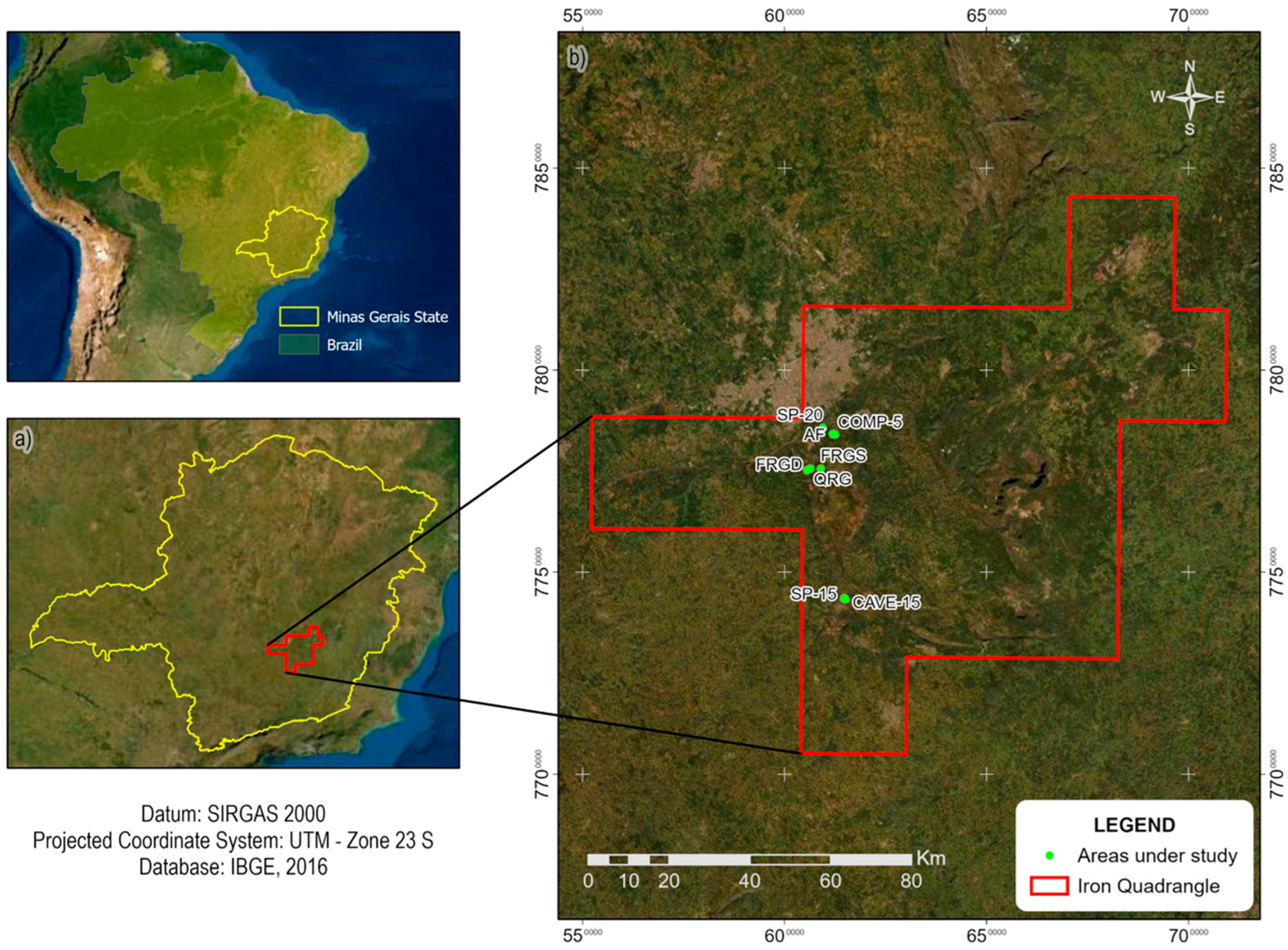
| Area | Localization | Latitude | Longitude | Altitude (m) |
|---|---|---|---|---|
| FRGS | CTF Miguelão | 20°06'49.5" O | 43°57'28.2" S | 1482 |
| FRGD | Serra da Calçada | 20°06'49.7" O | 43°58'58.8" S | 1277 |
| QRG | Serra da Calçada | 20°07'01.4" O | 43°59'24.4" S | 1459 |
| AF | Mata do Tumbá | 20°02'07.3" O | 43°55'48.5" S | 1014 |
| COMP-5 | Mata do Tumbá | 20°02'14.6" O | 43°55'27.1" S | 967 |
| SP-15 | Viaduto das Almas | 20°24'11.6" O | 43°54'00.4" S | 1330 |
| CAVE-15 | Viaduto das Almas | 20°24'20.1" O | 43°53'51.8" S | 1322 |
| SP-20 | Mina da Mutuca | 20°01'21.7" O | 43°57'12.2" S | 1122 |
2.2. Soil and vegetation analysis
2.3. Statistical Analysis
2.4. Indicators selection
2.5. Recovery Quality Index (RQI)
3. Results
3.1. Soil attributes and vegetation parameters
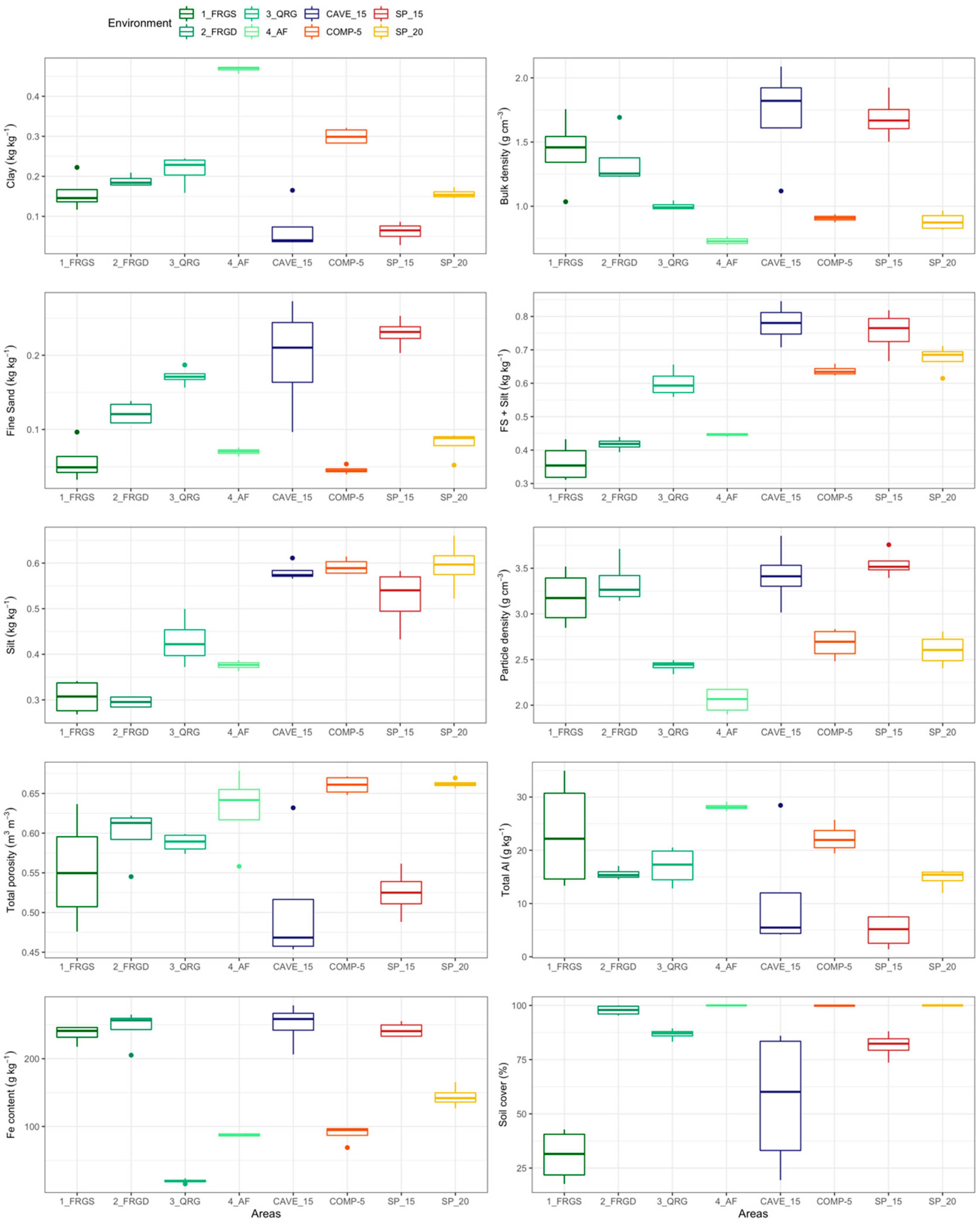
3.2. Selection and weighting of indicators
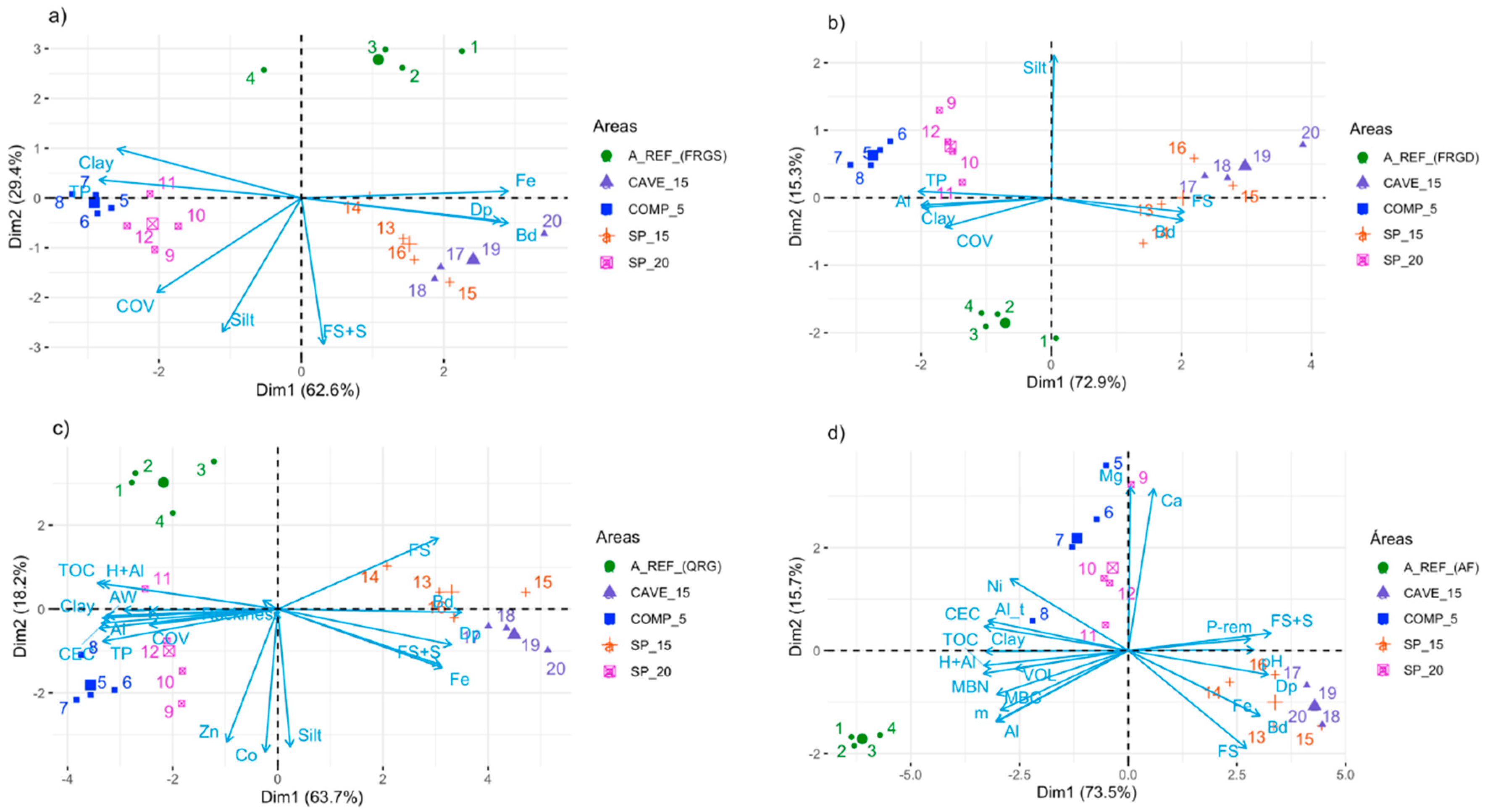
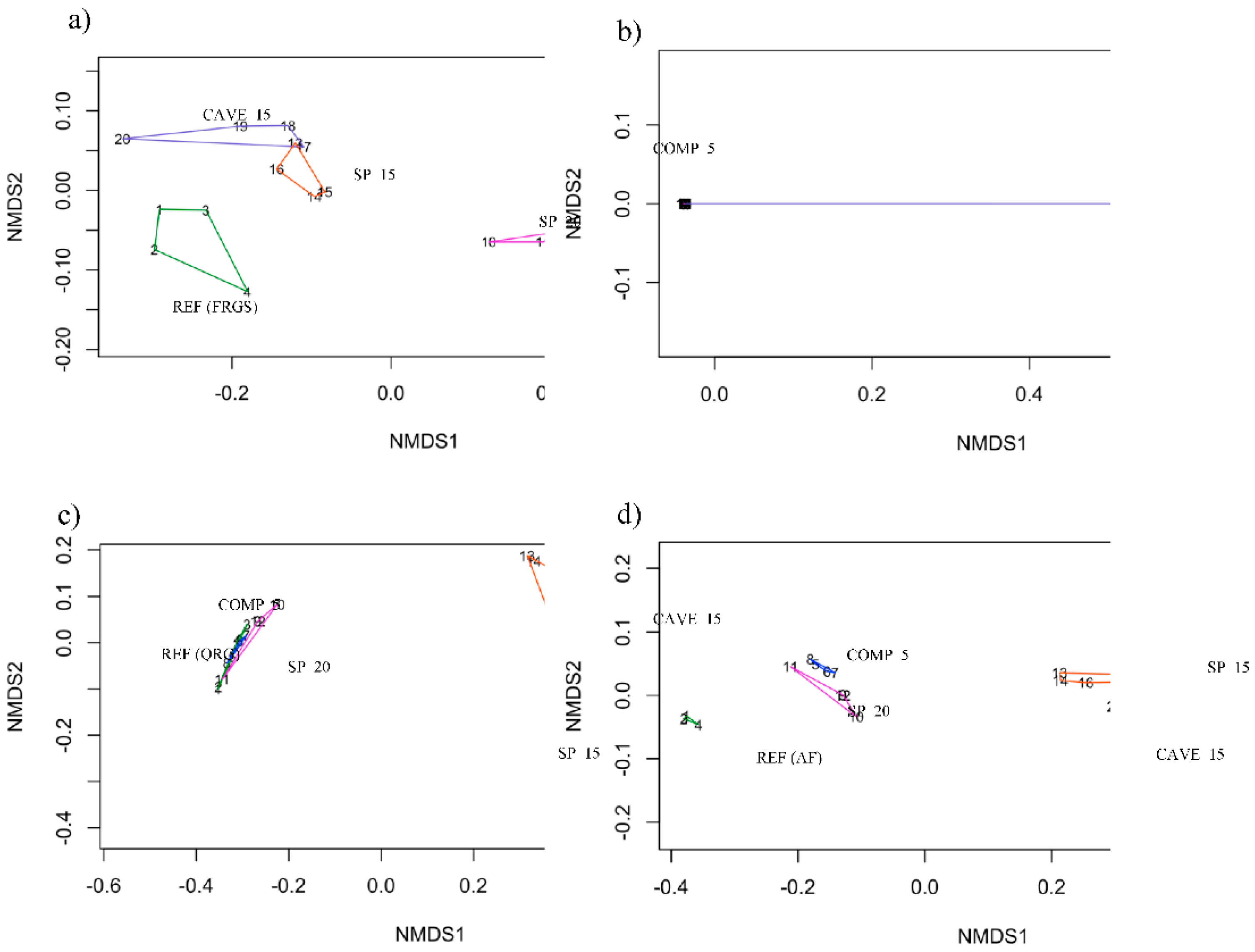
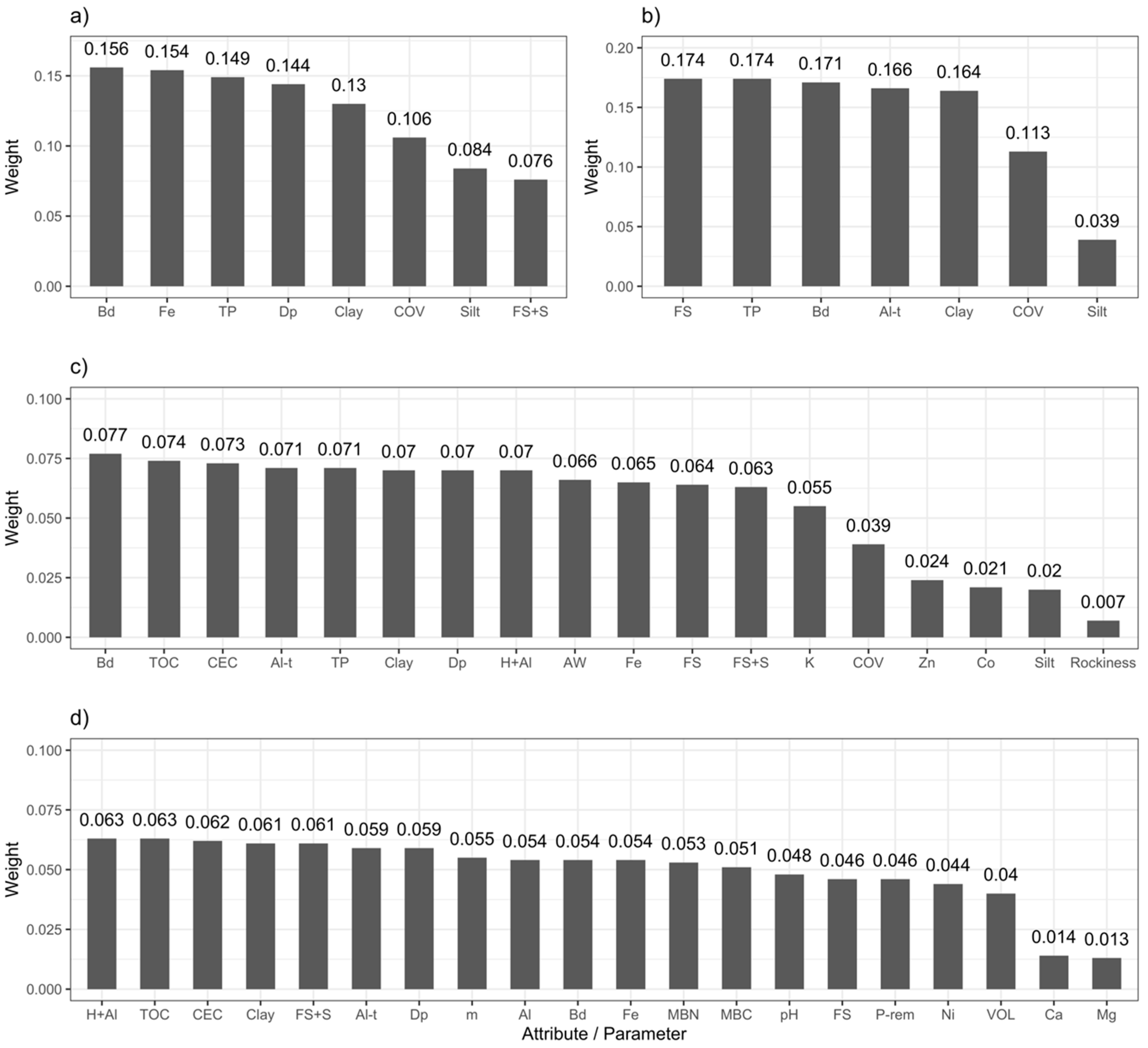
3.3. Restauration Quality Index (RQI)
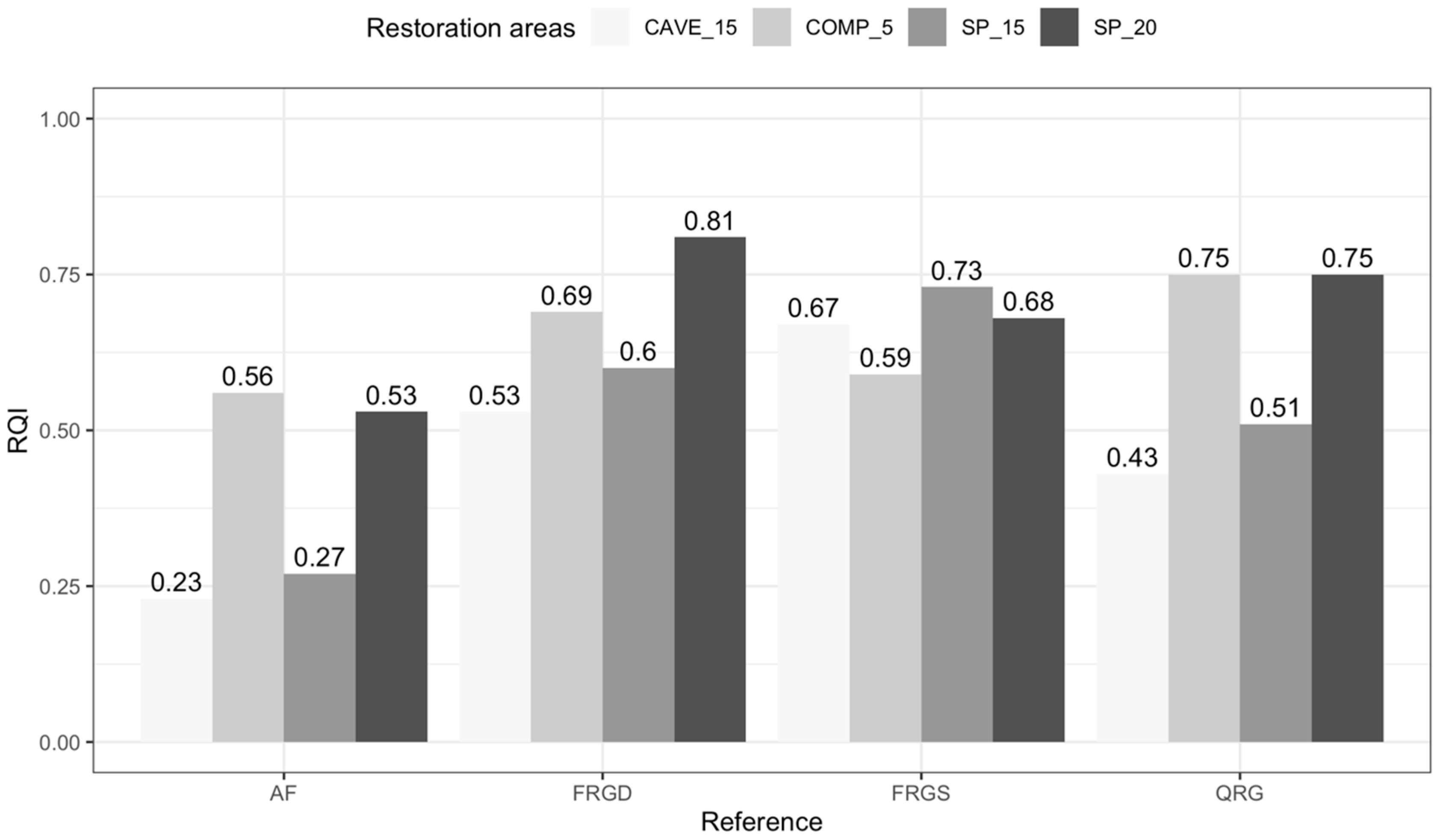
4. Discussion
4.1. Development and Interpretation of Recovery Quality Index (RQI) values
4.2. Recovery Quality Index of areas impacted by mining
4.3. Recovery Quality Assessment
5. Conclusions
Supplementary Materials
Acknowledgments
References
- Almeida, B.G. de, Freitas, P.L. de, Teixeira, W.G., Viana, J.H.M., Donagemma, G.K., 2017. Porosidade, in: Teixeira, P.C., Donagemma, G.K., Fontana, A., Teixeira, W.G. (Eds.), Manual de Métodos de Análise de Solo. Embrapa, Brasília, pp. 82–94.
- Almeida, R.O.P.O., Sánchez, L.E., 2015. Indicadores da qualidade do substrato para monitoramento de áreas de mineração revegetadas. Floresta e Ambient. 22, 153–163. https://doi.org/http://dx.doi.org/10.1590/2179-8087.072714. [CrossRef]
- Alvarez V., V.H., Novais, R.F., Cantarutti, R.B., Teixeira, P.C., Campos, D.V.B. de, 2017. Fósforo remanescente, in: Teixeira, P.C., Donagemma, G.K., Fontana, A., Teixeira, W.G. (Eds.), Manual de Métodos de Análise de Solo. Embrapa, Brasília, pp. 337–342.
- Anderson, T.-H., Domsch, K.H., 1993. The metabolic quotient for CO2 (qCO2) as a specific activity parameter to assess the effects of environmental conditions, such as pH, on the microbial biomass of forest soils. Soil Biol. Biochem. 25, 393–395.
- Anderson, T.-H., Domsch, K.H., 1989. Ratios of microbial biomass carbon to total organic carbon in arable soils. Soil Biol. Biochem. 21, 471–479. https://doi.org/10.1016/0038-0717(89)90117-X. [CrossRef]
- Andrews, S.S., Carroll, C.R., 2001. Designing a soil quality assessment tool for sustainable agroecosystem management. Ecol. Appl. 11, 1573–1585.
- ANM, 2019. Anuário Mineral Brasileiro: Principais Susbtâncias Metálicas 2018. Ano base 2017. ANM, Brasília (DF).
- Barbosa, B.D.S., Ferraz, G.A.S., Gonçalves, L.M., Marin, D.B., Maciel, D.T., Ferraz, P.F.P., Rossi, G., 2019. RGB vegetation indices applied to grass monitoring: a qualitative analysis. Agron. Res. 17, 349–357. https://doi.org/10.15159/AR.19.119. [CrossRef]
- Barrett, K.J., Cannon, J.B., Schuetter, A.M., Cheng, A.S., 2021. Effects of collaborative monitoring and adaptive management on restoration outcomes in dry conifer forests. For. Ecol. Manage. 488, 119018. https://doi.org/10.1016/J.FORECO.2021.119018. [CrossRef]
- Benites, V. de M., Cunha, T.J.F., Ferraz, R.P.D., Caiafa, A.N., Simas, F.N., Mendonça, E. de S., 2003. Caracterização dos solos em duas toposseqüências sobre diferentes litologias em áreas altimontanas na Serra da Mantiqueira. Embrapa Solos, Rio de Janeiro, RJ.
- Bhardwaj, A.K., Jasrotia, P., Hamilton, S.K., Robertson, G.P., 2011. Ecological management of intensively cropped agro-ecosystems improves soil quality with sustained productivity. Agric. Ecosyst. Environ. 140, 419–429. https://doi.org/10.1016/J.AGEE.2011.01.005. [CrossRef]
- Borges, S.R., 2013. Qualidade do solo em áreas em recuperação com forrageiras e cafeeiro pós-mineração de bauxita. Universidade Federal de Viçosa, Viçosa, Minas Gerais.
- Campos, D.V.B. de, Teixeira, P.C., Pérez, D.V., Saldanha, M.F.C., 2017a. Acidez potencial do solo, in: Teixeira, P.C., Donagemma, G.K., Fontana, A., Teixeira, W.G. (Eds.), Manual de Métodos de Análise de Solo. Embrapa, Brasília, pp. 233–237.
- Campos, D.V.B. de, Teixeira, P.C., Saldanha, M.F.C., Pérez, D.V., 2017b. Percentagem de saturação por alumínio, in: Teixeira, P.C., Donagemma, G.K., Fontana, A., Teixeira, W.G. (Eds.), Manual de Métodos de Análise de Solo. Embrapa, Brasília, pp. 245–246.
- Carmo, D.L. do, Silva, C.A., 2012. Métodos de quantificação de carbono e matéria orgânica em resíduos orgânicos. Rev. Bras. Ciências do Solo 36, 1211–1220. https://doi.org/https://doi.org/10.1590/S0100-06832012000400015. [CrossRef]
- Carvalho, F. De, Godoy, E.L., Lisboa, F.J.G., Moreira, F.M.D.S., Souza, F.A. De, Berbara, R.L.L., Fernandes, G.W., 2014. Relationship between Physical and Chemical Soil Attributes and Plant Species Diversity in Tropical Mountain Ecosystems from Brazil. J. Mt. Sci. 11, 875–883. https://doi.org/10.1007/s11629-013-2792-4. [CrossRef]
- Carvalho Filho, A. de, 2008. Solos e ambientes do quadrilátero ferrífero (MG) e aptidão silvicultural dos tabuleiros costeiros. Universidade Federal de Lavras, Lavras, Minas Gerais.
- Coelho, M.R., Vasques, G. de M., Tassinari, D., Souza, Z.R. de, Oliveira, A.P. de, Moreira, F.M. de S., 2017. Solos do Quadrilátero Ferrífero sob diferentes coberturas vegetais e materiais de origem, BOLETIM DE PESQUISA E DESENVOLVIMENTO 264. Rio de Janeiro, RJ.
- Costa, S.Â.D. da C., 2003. Caracterização química, física, mineralógica e classificação de solos ricos em ferro do Quadrilátero Ferrífero. Universidade Federal de Viçosa, Viçosa, Minas Gerais.
- Daws, M.I., Walters, S.J., Harris, R.J., Tibbett, M., Grigg, A.H., Morald, T.K., Hobbs, R.J., Standish, R.J., 2021. Nutrient enrichment diminishes plant diversity and density, and alters long-term ecological trajectories, in a biodiverse forest restoration. Ecol. Eng. 165, 106222. https://doi.org/10.1016/J.ECOLENG.2021.106222. [CrossRef]
- Donagemma, G.K., Viana, J.H.M., Almeida, B.G. de, Ruiz, H.A., Klein, V.A., Dechen, S.C.F., Fernandes, R.B.A., 2017. Análise granulométrica, in: Teixeira, P.C., Donagemma, G.K., Fontana, A., Teixeira, W.G. (Eds.), Manual de Métodos de Análise de Solo. Embrapa, Brasília, pp. 95–116.
- Ferreira, A.S., Camargo, F.A.O., Vidor, C., 1999. Utilização de microondas na avaliação da biomassa microbiana do solo. Rev. Bras. Ciência do Solo 23, 991–996.
- Figueiredo Filho, D.B., Silva Júnior, J.A. da, 2010. Visão além do alcance: Uma introdução à análise fatorial. Opiniao Publica 16, 160–185. https://doi.org/10.1590/S0104-62762010000100007. [CrossRef]
- Fischer, J., Riechers, M., Loos, J., Martin-Lopez, B., Temperton, V.M., 2021. Making the UN Decade on Ecosystem Restoration a Social-Ecological Endeavour. Trends Ecol. Evol. 36, 20–28. https://doi.org/10.1016/J.TREE.2020.08.018. [CrossRef]
- Guerra, M.B.B., Neto, E.L., Prianti, M.T.A., Pereira-Filho, E.R., Schaefer, C.E.G.R., 2013. Post-fire study of the Brazilian Scientific Antarctic Station: Toxic element contamination and potential mobility on the surrounding environment. Microchem. J. 110, 21–27. https://doi.org/10.1016/j.microc.2013.01.007. [CrossRef]
- IBAMA, 2011. Instrução normativa no 04 de 13 de abril de 2011. Estabelece procedimentos para elaboração de Projeto de Recuperação de Área Degradada - PRAD ou Área Alterada, para fins de cumprimento da legislação ambiental. Brasília, , Brasil.
- IBAMA, 1990. Manual Técnico de Recuperação de Áreas Degradadas pela Mineração: Técnicas de Revegetação.
- Jacobi, C.M., Do Carmo, F.F., 2008. The Contribution of Ironstone Outcrops to Plant Diversity in the Iron Quadrangle, a Threatened Brazilian Landscape. Ambio 37, 321–322. https://doi.org/10.1579/0044-7447(2008)37[321:CCPICI]2.0.CO;2. [CrossRef]
- Jolliffe, I.T., Cadima, J., 2016. Principal component analysis: a review and recent developments. Philos. Trans. R. Soc. A Math. Phys. Eng. Sci. 374, 1–16. https://doi.org/10.1098/rsta.2015.0202. [CrossRef]
- Karlen, D.L., Wollenhaupt, N.C., Erbach, D.C., Berry, E.C., Swan, J.B., Eash, N.S., Jordahl, J.L., 1994. Crop residue effects on soil quality following 10-years of no-till corn. Soil Tillage Res. 31, 149–167. https://doi.org/10.1016/0167-1987(94)90077-9. [CrossRef]
- Leonardi, F.A., 2014. O mapeamento, caracterização e datação de perfis laterísticos para identificação e correlação de superfícies geomórficas: estudo de caso do Quadrilátero Ferrífero. Universidade Estadual de Campinas, Campinas, SP.
- Lima, M.T., Tonello, K.C., Leite, E.C., Franco, F.S., Júlia, C., Corrêa, P., 2020. Dinâmica da recuperação ambiental de pilhas de estéril em mineração de calcário por regeneração natural. Eng. Sanitária e Ambient. 25, 11–19. https://doi.org/10.1590/S1413-41522020180571. [CrossRef]
- Liu, Y., Li, H., Huang, S., An, H., Santagata, R., Ulgiati, S., 2020. Environmental and economic-related impact assessment of iron and steel production. A call for shared responsibility in global trade. J. Clean. Prod. 269, 122239. https://doi.org/10.1016/j.jclepro.2020.122239. [CrossRef]
- Magnusson, B., Örnemark, U., 2014. Eurachem guide: The fitness for purpose of analytical methods- A laboratory guide to method validation and related topics, 2nd ed, Eurachem Guide, ISBN: 0-94948926-12-0.
- Martins, W.B.R., Lima, M.D.R., Barros Junior, U. de O., Amorim, L.S.V.-B., Oliveira, F. de A., Schwartz, G., 2020. Ecological methods and indicators for recovering and monitoring ecosystems after mining: A global literature review. Ecol. Eng. 145, 105707. https://doi.org/10.1016/J.ECOLENG.2019.105707. [CrossRef]
- Melo Filho, J.F. de, Souza, A.L.V., Souza, L. da S., 2007. Determinação do índice de qualidade subsuperficial em um Latossolo amarelo coeso dos tabuleiros costeiros, sob floresta natural. Rev. Bras. Ciência do Solo 31, 1599–1608.
- Mukhopadhyay, S., Maiti, S.K., Masto, R.E., 2014. Development of mine soil quality index (MSQI) for evaluation of reclamation success: A chronosequence study. Ecol. Eng. 71, 10–20. https://doi.org/10.1016/J.ECOLENG.2014.07.001. [CrossRef]
- Pereira, A.F.S., 2010. Florística, fitossociologia e relação solo-vegetação em campo rupestre ferruginoso do Quadrilátero Ferrífero, MG. Universidade Federal de Viçosa, Viçosa, Minas Gerais.
- Pinho, B.X., de Melo, F.P.L., Arroyo-Rodríguez, V., Pierce, S., Lohbeck, M., Tabarelli, M., 2018. Soil-mediated filtering organizes tree assemblages in regenerating tropical forests. J. Ecol. 106, 137–147. https://doi.org/10.1111/1365-2745.12843. [CrossRef]
- Prach, K., Durigan, G., Fennessy, S., Overbeck, G.E., Torezan, J.M., Murphy, S.D., 2019. A primer on choosing goals and indicators to evaluate ecological restoration success. Restor. Ecol. 27, 917–923. https://doi.org/10.1111/REC.13011. [CrossRef]
- R Core Team, 2022. R: A language and environment for statistical computing.
- Ribeiro, P.C.D., Menendez, E., da Silva, D.L., Bonieck, D., Ramírez-Bahena, M.H., Resende-Stoianoff, M.A., Peix, A., Velázquez, E., Mateos, P.F., Scotti, M.R., 2017. Invasion of the Brazilian campo rupestre by the exotic grass Melinis minutiflora is driven by the high soil N availability and changes in the N cycle. Sci. Total Environ. 577, 202–211. https://doi.org/10.1016/J.SCITOTENV.2016.10.162. [CrossRef]
- Rossi, D.Q., 2014. Estratigrafia e arcabouço estrutural da regioão de Fábrica Nova, Quadrilátero Ferrífero, Minas Gerais. Universidade Federal de Ouro Preto.
- Schaefer, C.E.G.R., Candido, H.G., Corrêa, G.R., Pereira, A., Nunes, J.A., Souza, O.F., Marins, A., Fernandes-Filho, E., Ker, J.C., 2015. Solos desenvolvidos sobre canga ferruginosa no Brasil: uma revisão crítica e papel ecológico de termiteiros, in: Carmo, F.F., Kamino, L.H.Y. (Eds.), Geossistemas Ferruginosos Do Brasil: Áreas Prioritárias Para Conservação Da Diversidade Geológica e Biológica, Patrimônio Cultural e Serviços Ambientais. 3i Editora, Belo Horizonte, pp. 77–102.
- Schaefer, C.E.G.R., Mendonça, B.A.F., Ribeiro, A.S., 2008. Solos desenvolvidos sobre canga ferruginosa no Quadrilátero Ferrífero, Minas Gerais, in: Simpósio Afloramentos Ferruginosos No Quadrilátero Ferrífero: Biodiversidade, Conservação e Perspectivas de Sustentabilidade. UFMG/ICB, Belo Horizonte, MG.
- Selle, G.L., 2007. Ciclagem de nutrientes em ecossistemas florestais. Biosci. J. 23, 29–39.
- SER, 2004. Princípios da SER International sobre a restauração ecológica [WWW Document]. Soc. Ecol. Restor. URL https://cdn.ymaws.com/www.ser.org/resource/resmgr/custompages/publications/SER_Primer/ser-primer-portuguese.pdf (accessed 4.14.20).
- Silva, G.P., Fontes, M.P.F., da Costa, L.M., de Barros, N.F., 2006. Caracterização química, física e mineralógica de estéreis e rejeito da mineração de ferro da mina de Alegria, Mariana-Mg. Pesqui. Agropecuária Trop. 36, 45–52.
- Sousa, S.S. de, Freitas, D.A.F., Latini, A.O., Silva, B.M., Viana, J.H.M., Campos, M.P., Peixoto, D.S., Botula, Y.-D., 2020. Iron ore mining areas and their reclamation in Minas Gerais State, Brazil: impacts on soil physical properties. SN Appl. Sci. 2, 1–13. https://doi.org/10.1007/s42452-020-03457-9. [CrossRef]
- Stotzky, G., 1965. Microbial Respiration, in: Norman, A.G. (Ed.), Methods of Soil Analysis, Part 2: Chemical and Microbiological Properties. American Society of Agronomy, New York, pp. 1550–1572. https://doi.org/10.2134/agronmonogr9.2.2ed.c62. [CrossRef]
- Tedesco, M.J., Volkweiss, S.J., Bohmen, H., 1985. Análises de solo, plantas e outros materiais. Universidade Federal do Rio Grande do Sul (Ufrs), Faculdade de Agronomia, Porto Alegre (RS).
- Teixeira, P.C., Campos, D.V.B. de, Bianchi, S.R., Pérez, D.V., Saldanha, M.F.C., 2017a. Cátions trocáveis, in: Teixeira, P.C., Donagemma, G.K., Fontana, A., Teixeira, W.G. (Eds.), Manual de Métodos de Análise de Solo. Embrapa, Brasília, pp. 209–232.
- Teixeira, P.C., Campos, D.V.B. de, Saldanha, M.F.C., 2017b. pH do solo, in: Teixeira, P.C., Donagemma, G.K., Fontana, A., Teixeira, W.G. (Eds.), Manual de Métodos de Análise de Solo. Embrapa, Brasília, pp. 199–202.
- Teixeira, P.C., Campos, D.V.B. de, Saldanha, M.F.C., 2017c. Fósforo disponível, in: Teixeira, P.C., Donagemma, G.K., Fontana, A., Teixeira, W.G. (Eds.), Manual de Métodos de Análise de Solo. Embrapa, Brasília, pp. 203–208.
- Teixeira, P.C., Campos, D.V.B. de, Saldanha, M.F.C., Pérez, D.V., 2017d. Complexo sortivo do solo (Soma de bases trocáveis, CTC efetiva, CTC total, Percentagem de saturação por bases), in: Teixeira, P.C., Donagemma, G.K., Fontana, A., Teixeira, W.G. (Eds.), Manual de Métodos de Análise de Solo. Embrapa, Brasília, pp. 240–244.
- Teixeira, W.G., Behring, S.B., 2017. Reteção de água no solo pelos métodos da mesa de tensão e da câmara de Richards, in: Teixeira, P.C., Donagemma, G.K., Fontana, A., Teixeira, W.G. (Eds.), Manual de Métodos de Análise de Solo. Embrapa, Brasília, pp. 34–46.
- Torres Ribeiro, K., Freitas, L., 2010. Impactos potenciais das alterações no Código Florestal sobre a vegetação de campos rupestres e campos de altitude. Biota Neotrop. 10, 239–246.
- United Nations Environment Agency, 2019. Resolution 73/284: United Nations Decade on Ecosystem Restoration (2021–2030).
- Viana, J.H.M., Teixeira, W.G., Donagemma, G.K., 2017. Densidade de partículas, in: Teixeira, P.C., Donagemma, G.K., Fontana, A., Teixeira, W.G. (Eds.), Manual de Métodos de Análise de Solo. Embrapa, Brasília, pp. 76–81.
- Wortley, L., Hero, J.M., Howes, M., 2013. Evaluating ecological restoration success: A review of the literature. Restor. Ecol. 21, 537–543. https://doi.org/10.1111/REC.12028. [CrossRef]
- Wymore, A.W., 1993. Model-Based Systems Engineering, 1st Editio. ed, Model-Based Systems Engineering. CRC Press, Boca Raton. https://doi.org/10.1201/9780203746936. [CrossRef]
Disclaimer/Publisher’s Note: The statements, opinions and data contained in all publications are solely those of the individual author(s) and contributor(s) and not of MDPI and/or the editor(s). MDPI and/or the editor(s) disclaim responsibility for any injury to people or property resulting from any ideas, methods, instructions or products referred to in the content. |
© 2023 by the authors. Licensee MDPI, Basel, Switzerland. This article is an open access article distributed under the terms and conditions of the Creative Commons Attribution (CC BY) license (http://creativecommons.org/licenses/by/4.0/).





